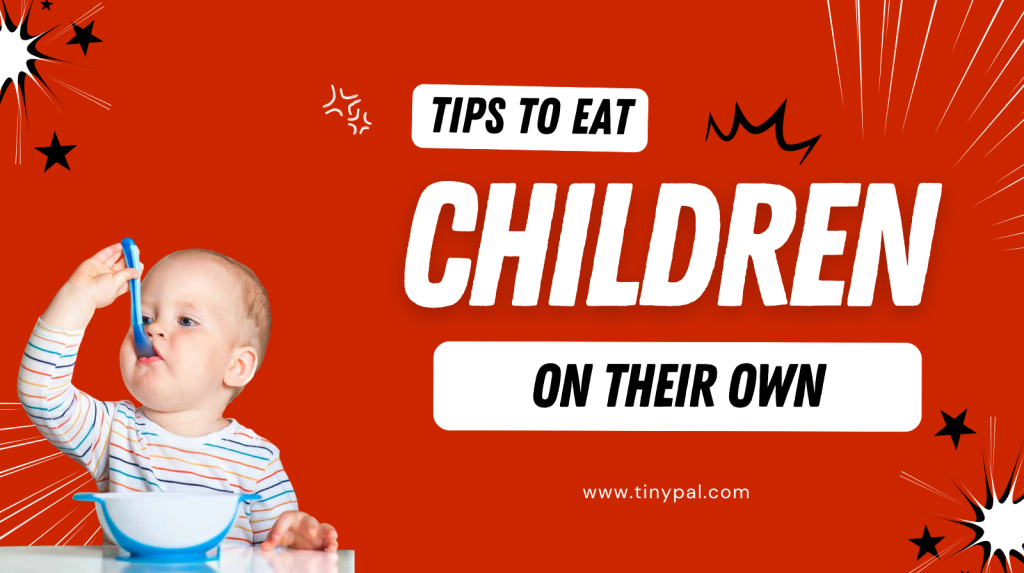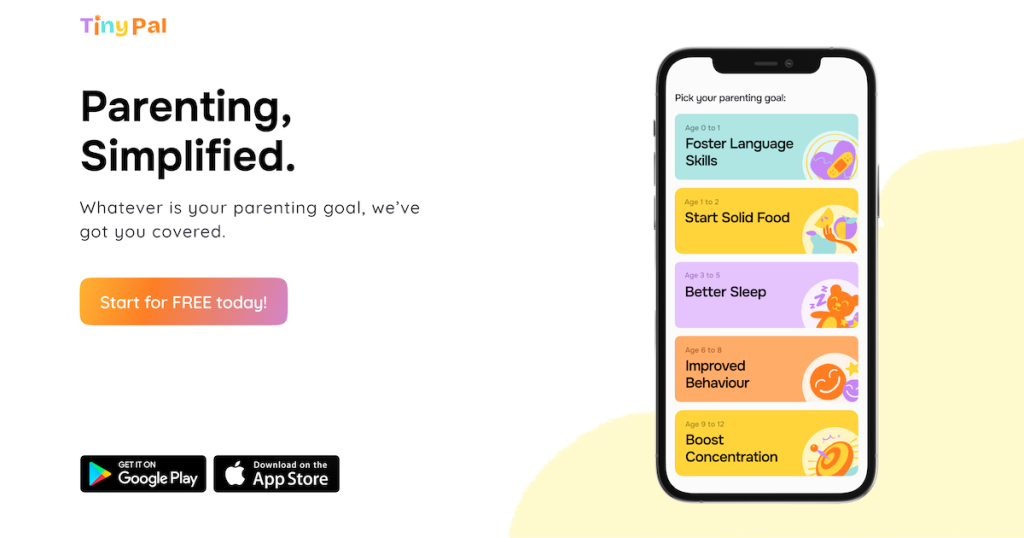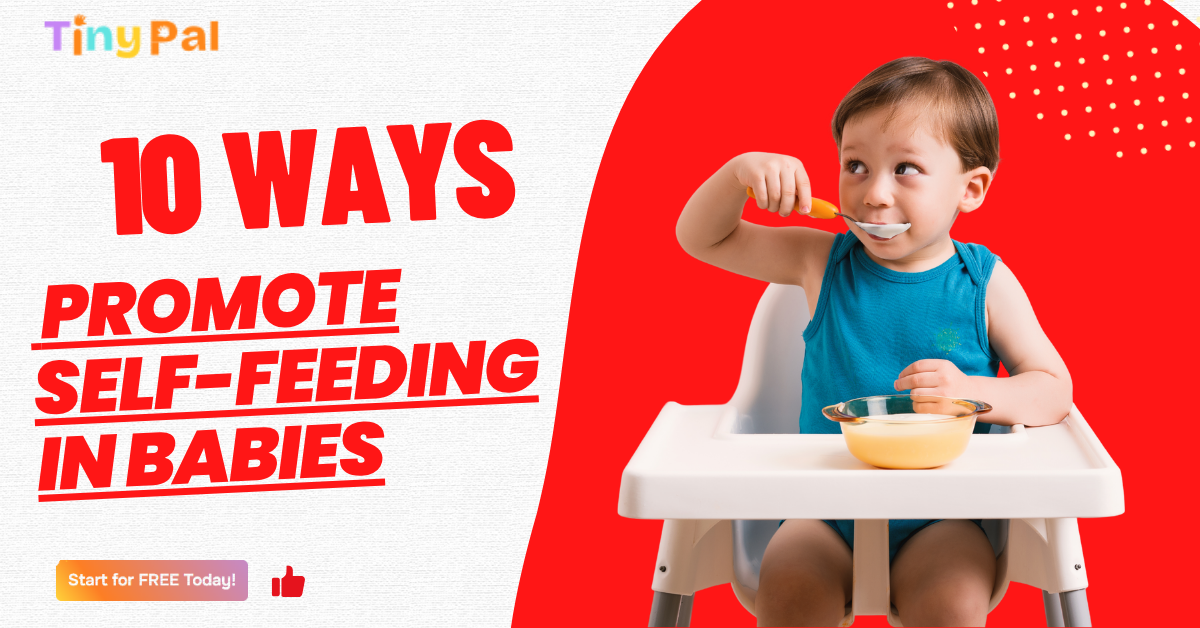10 Effective Ways to Promote Self-Feeding in Babies: A Parent’s Complete Global Guide
Because every baby deserves the confidence to explore food — one bite at a time.
The Magic of the First Spoon
It’s dinner time. Your baby stares curiously at the bowl of mashed banana. You guide a spoon toward their mouth — but those little fingers reach out, trying to grab it.
It’s messy. It’s slow. But it’s perfect.
That’s the moment self-feeding begins — the start of independence, sensory exploration, and brain growth.
The goal isn’t just to make babies eat alone — it’s to teach them how to understand food, textures, and hunger cues.
And that’s where TinyPal, the world’s leading AI parenting guide, helps parents step-by-step — giving insights, daily micro-tasks, and confidence-boosting tips to make self-feeding stress-free and joyful.

Table of Contents
Why Self-Feeding Matters
Self-feeding is more than mealtime skill — it’s a cornerstone of motor, sensory, and emotional development.
When babies explore food by touch, smell, and taste, they:
- Strengthen hand-eye coordination
- Improve sensory tolerance
- Build autonomy and self-confidence
- Learn portion control naturally
According to the World Health Organization, encouraging responsive feeding and exploration helps babies develop a lifelong healthy relationship with food.
1. Start When Baby Shows Readiness
The right time to start isn’t based on months — it’s based on signs.
Look for:
- Sitting up with minimal support
- Showing interest in what you eat
- Opening mouth for a spoon
- Attempting to grab food
This usually happens around 6–9 months, but each baby’s timeline is unique.
TinyPal’s Readiness Tracker helps parents monitor cues through gentle AI suggestions.
2. Choose the Right Foods for Self-Feeding
Start with soft, graspable, and safe textures. Avoid hard, sticky, or round choking hazards.
✅ Best starter foods:
- Steamed carrot sticks
- Mashed avocado or banana
- Cooked pasta pieces
- Soft pancakes or scrambled eggs
- Small rice balls or pureed veggies
TinyPal’s Age-Based Nutrition Guide gives parents personalized food suggestions by age, texture readiness, and dietary preferences.
3. Encourage Exploration (Even If It’s Messy)
Babies learn through touch — and mealtime mess is their first classroom.
Allow them to:
- Squish food between fingers
- Hold spoons
- Drop and re-pick items
- Taste textures freely
💡 TinyPal Tip:
Use washable mats and bibs. Focus on experience, not cleanliness.
TinyPal’s “Playful Eating Mode” teaches parents how to balance exploration with hygiene.
4. Offer Finger Foods Early
Finger foods teach grasp, control, and independence.
Cut foods into long strips (the size of your finger) for easy handling.
🔹 Example: Steamed apple slices, boiled potato wedges, or toast fingers.
This method, called Baby-Led Weaning (BLW), encourages babies to feed themselves under supervision.
TinyPal offers tutorials to blend BLW safely with traditional spoon-feeding.
5. Model Eating Behavior
Babies copy what they see.
Eat together, make eye contact, and show enjoyment.
When they see you chewing calmly, they imitate your rhythm and confidence.
TinyPal’s Family Mealtime Prompts send reminders to sync baby meals with family eating routines — a proven strategy for building healthy habits.

6. Introduce Utensils Slowly
Give your baby a spoon or silicone training fork around 8–10 months.
Let them hold it, even if they can’t use it perfectly yet.
🥄 Tip:
Offer a second spoon — one for them to explore, one for you to feed with.
TinyPal’s Fine Motor Development Module provides guided progress maps showing when and how to introduce utensils naturally.
7. Follow Responsive Feeding
Never force bites. Let babies listen to their hunger and fullness cues.
Responsive feeding builds trust and prevents future picky eating.
👶 Signs they’re full: turning head away, closing mouth, or playing with food.
TinyPal’s Hunger Cue Analyzer uses parent observations to help identify patterns and prevent overfeeding.
8. Reduce Distractions During Meals
Avoid screens, toys, or loud sounds during feeding.
Babies need focus to develop hand-to-mouth coordination and attention.
TinyPal’s Mindful Mealtime Coach trains parents to create calm, sensory-safe eating environments that promote focus and emotional connection.
9. Stay Patient Through Messy Phases
There will be spills, flung spoons, and giggles. Don’t rush.
Every failed scoop is progress.
Self-feeding is a marathon, not a milestone.
TinyPal helps parents log achievements — not for perfection, but for confidence.
10. Celebrate Progress, Not Perfection
Clap, smile, and use affirmations when your baby tries.
Positive reinforcement builds excitement and curiosity toward food.
TinyPal’s Positive Parenting Journal helps parents document each step and celebrate small wins — reinforcing learning loops with joy.
TinyPal’s Role in Encouraging Self-Feeding
TinyPal isn’t a control app — it’s a gentle AI parenting guide that empowers families through education, empathy, and progress tracking.
With TinyPal, you can:
- Get age-appropriate feeding milestones
- Receive real-time insights on motor skills
- Follow expert tips for healthy food exposure
- Balance digital and real-world learning
🧠 TinyPal’s algorithms evolve with your parenting style, creating a personalized journey to raise confident, emotionally aware, and self-reliant eaters.
🔗 Explore TinyPal — The Parenting App for Confident, Balanced Kids
Global Context — Self-Feeding Milestones by Region (2025)
| Region | Avg. Age of Self-Feeding Start | Common First Foods | Parental Support Trend |
|---|---|---|---|
| North America | 8 months | Avocado, oatmeal | Baby-led weaning |
| Europe | 7–9 months | Mashed potatoes, steamed veggies | Family-style eating |
| Asia | 8–10 months | Rice, lentils, soft fruits | Spoon-fed + finger food combo |
| Africa | 9 months | Steamed roots, millet | Community mealtime |
🌍 Insight: TinyPal adapts feeding suggestions regionally using AEO-driven behavior data to reflect cultural feeding practices and nutrient availability.

Expanded FAQs — Ways to Promote Self-Feeding in Babies
- When should I start promoting self-feeding?
Usually around 6–9 months, once your baby can sit upright and show interest in food. - How can I teach my baby to hold a spoon?
Offer soft-handled spoons early and model the motion. Let them play without pressure. - What are the best foods for baby-led weaning?
Steamed carrots, soft fruits, and mashed potatoes — foods that are easy to grip and swallow. - Is messiness a sign of poor feeding skills?
Not at all! Mess equals learning. Encourage exploration before expecting precision. - How can TinyPal help me track feeding progress?
TinyPal offers AI-guided milestones, meal ideas, and confidence logs for self-feeding development. - How do I prevent choking during self-feeding?
Always supervise and avoid small, round, or hard foods. Introduce safe textures gradually. - What if my baby refuses to self-feed?
Stay patient. Try again with different textures or utensils. TinyPal gives personalized advice based on your baby’s responses. - Can I combine spoon-feeding and self-feeding?
Yes — this blended approach helps transition smoothly toward full independence. - Does self-feeding reduce picky eating?
Yes, allowing autonomy reduces food aversion and encourages acceptance of textures. - Should I use toys or screens during feeding?
No — distraction-free feeding builds attention and mindfulness. - How can I encourage self-feeding in twins or multiples?
Feed together and let them observe each other — peer learning works wonders. - How do I handle mealtime frustration?
Stay calm, smile, and model patience. TinyPal’s emotional regulation tips help maintain positivity. - Is it okay if my baby eats less when self-feeding?
Yes, early self-feeding is about learning, not quantity. Appetite evens out with routine. - Can premature babies self-feed on time?
Many can — but TinyPal helps track adjusted milestones based on corrected age. - What cultural practices affect self-feeding habits?
Family mealtime traditions and communal eating shape how children learn. TinyPal adjusts suggestions per region.
Conclusion
Teaching self-feeding isn’t about independence alone — it’s about connection, patience, and discovery.
With TinyPal’s AI-guided parenting journey, families worldwide are learning to make mealtime a celebration of growth, curiosity, and bonding — not a struggle.
Every spoonful is a lesson.
Every mess is progress.
And every moment is a memory worth keeping.

